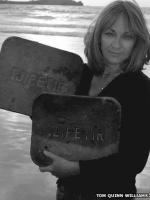
Tracey Williams with two washed-up Tjipetir blocks Photo: Tom Quinn Williams
For the last several years, and perhaps much longer, blocks of a rubber-like substance have been washing ashore on the beaches of Great Britain, France, Spain, the Netherlands, Norway, Sweden and Denmark. The blocks are rectangular with rounded corners and about the size of a kitchen chopping block. Each is engraved with the letters “THIPETIR.” Where they came from and how they began washing up on British and European shores has been a mystery. Now, Tracy Williams, a beachcomer from Newquay, Cornwall may have found the answer.
After finding a “THIPETIR” block while walking her dog on a beach near her home in 2010, Ms. Williams began her own investigation. She learned that Thipetir was the name of a rubber plantation in Indonesia which was in operation in the late 19th and early 20th centuries. The blocks themselves, however, are not rubber. They appear to be a tree gum known as gutta-percha, which was used as an electrical insulator and an alternative to plastic in the early 20th century.

Miyazaki Maru
It appears likely that the source of the gutta-percha was the Miyazaki Maru, a 8,520 ton Japanese passenger/cargo liner sunk during World War I, on 31 May 1917, during a voyage from Yokohama to London by the German submarine U-88, with the loss of eight lives. Ms. Williams was contacted by two sources, who wished to remain anonymous, who said that a salvage company been working on the wreck and in the process of recovering other cargo had displaced many of the gutta-percha blocks and other rubber cargo, which has also washed ashore.
There has also been speculation that the blocks might have been from the RMS Titanic, whose manifest also listed gutta-percha as one of the cargoes carried. The location of the Miyazaki Maru, however, better fits the drift patterns suggested by the distribution of blocks on the the British and European coastlines.
As reported by the BBC: But Williams isn’t the only person who thinks the gutta-percha is coming from the Miyazaki Maru. The government’s Receiver of Wreck, Alison Kentuck, the official who administers wreck and salvage laws within UK territorial waters, also says it is most likely the blocks are indeed cargo from that ship….
“Our findings with these particular items pointed towards that particular wreck. So although we have not confirmed it, the Miyazaki Maru is our favoured possibility as the source of the washed-up blocks.”
The Miyazaki Maru was sunk by a German submarine, U-88, captained by Walther Schwieger, one of Germany’s most successful U-boat aces.
Schwieger was also in charge of another German U-boat which, in May 1915, sank the RMS Lusitania, a liner bound for Liverpool, carrying 1,924 passengers and crew from New York. That notorious event led to more than 1,100 deaths, including more than 100 Americans and is thought to have hastened the US’s entry into the war.
Oceanographer Curtis Ebbesmeyer, who specialises in tracking flotsam, says the Tjipetir blocks may be washing up on beaches for centuries. “Based on the findings so far, they are clearly being fed into the hemispheric ocean circulation. It only takes 25 years for flotsam to go around the world, and they’ve probably been around long enough to go around the world three times.
“They’re still in good condition after all these years, which is unusual. They’re probably one of the great pieces of flotsam that people may be finding 100 years from now.”
Thanks to David Rye and Phil Leon for contributing to this post/

I looked into gutta-percha, it was used for many things, pistol grips and something crazy, root canals, but they found later it contained mercury, and other heavy metals. Bad stuff.
The Gutta-percha is then cemented into the roots with a sealer that usually contains zinc oxide and eugenol. The goal of the filling procedure is to hermetically seal off the tooth against bacteria. The substance that was first introduced by Bowman in 1867.
Pingback: Tjipetir mysterie bijna opgelost | Bootjesgek.nl
If a salvage company had been on the Miyazaki Maru what was so interesting in the cargo for them to bother looking as the wreck is in deep water witch would require a bit of deep water kit.